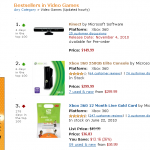Weekly News Roundup (20 June 2010)
The World Cup is taking up a lot more of my time than I had estimated earlier, despite the paucity of good football on show. I was expecting a mid week update for the NPD figures, but NPD are delaying the release of the numbers until later. Technical difficulties are blamed, or may be they were too busy watching the World Cup too. Other may also have been busy with the games, because there isn’t a whole lot of news this week either (again, it could just be because I haven’t been looking as hard).

Let’s start with copyright news. Bad news for UK HDTV viewers, as Ofcom officially agrees to the BBC’s demand to add DRM to all upcoming HDTV equipment. The BBC used the same argument as the MPAA when they also wanted DRM to be added to TVs, and guess what, it worked.
The BBC argued that having DRM means they can bring more high value content to people’s screen via free to air TV. Of course, the lack of DRM hasn’t prevented them, and others, from bringing the same high value content before, and the way Ofcom has set out this thing, people with older PVRs (or ones that don’t belong to the Freeview standard) will still be able to record the DRM’d content most likely. So what’s the whole point of this? Basically just like any other DRM scheme, to give copyright holders a false sense of security, which in their opinion, is better than none.
It’s been a bad time for LimeWire, as they’ve been sued again, just a week after the RIAA claimed that they deserve billions of dollars of damages stemming from LimeWire’s operation. This time, it’s the National Music Publishers’ Association that is doing the suing. The billions in damages that the RIAA want is simply ridiculous. It’s basically saying that the people who downloaded music illegally on LimeWire’s network and zero dollars in the process would have otherwise spent billions of dollars has LimeWire not existed. It’s like saying, using an analogy that the industry just loves, that a car thief would have paid full sticker price for a car if he hadn’t stolen one. At least with the car, there is actual physical loss (the car owner loses something that can’t be replaced without spending more money) – there is none with digital files, not when the owner can make infinite copies at no cost.
And it seems I’m not the only one that thinks the industry’s estimates for losses are greatly exaggerated, to put it mildly. Experts testifying before the US International Trade Commission are saying exact this. The best quote I’ve found is this one, made by Harvard Professor Fritz Foley: “It seems a bit crazy to me to assume that someone who would pay some low amount for a pirated product would be the type of customer who’d pay some amount that’s six or 10 that amount for a real one.”
The very type of people who would get pirated content at low cost (or for free) is exactly the type of people that probably can’t afford to pay for the legitimate version. This isn’t always true, but with so much content available at varying cost, you’ll have to be a millionaire to be able to afford to pay the cost of stuff that web pirates are downloading for free. And yet, the industry seriously believe that if they can just wipe out piracy completely, then all those people who aren’t paying for stuff will automatically start paying full price for everything. And what are these pirates doing with all these lost billions every year if they’re not spending it on legitimate buys? They must be laughing all the way to the bank where their vast amount of savings are stored, savings that are the result of not having to pay $0.99 for songs.
At the hearing, which was organised by the USITC at the request of the US Senate’s Finance Committee (who are trying to work out how much blame China should get in terms of Intellectual Property damage), some experts even expressed the controversial view that counterfeit goods actually helps the economy by employing people and making it possible for financially challenged people to spend money on stuff, even if it is just a fraction of the retail price. By extension, it will be interesting to find out if web piracy is also contributing to the economy, in terms of advertising, creating product hype and contributing to people spending money on Internet services (this point the copyright holders will agree with, as they have continuously blamed ISPs for profiting from piracy).
A IEEE working group is trying to create a new DRM standard that at least gives consumers some rights when it comes to managing their own content. The goal is to basically ensure once people purchase digital content with DRM, they are entitled to the same rights as people who purchase something physical. Including the ability to “loan” out your digital content to a friend. So to mirror a non digital physical object (say a VHS tape, if people still remember those things), the content cannot be duplicated (without quality loss), but can be loaned out as the “ownership license” is temporarily transfered to your friend, but with the risk that your friend might then pass on the “ownership” to others (ie. lose your tape, the bastard), and thus prevent mass distribution/sharing. It all sounds reasonable in principle, but the whole point of digital is that you have more flexibility than physical objects/media, and getting rid of the one of the major advantages of digital content seems kind of self-defeating to me. I still believe that the best way to prevent people from obtaining content illegally is to give them good reasons to pay for content, which includes things such as access to a superior catalog of content, additional services that pirates can’t offer, along with prices that are so reasonable that it makes pirated content look decidedly bad value in comparison.
And that may be what Nintendo is doing with their new 3DS console when it comes to the fight against piracy. Instead of releasing a new DRM scheme (which Nintendo may still do), they are copying some of features of the flash carts that have made piracy so easy. One of the more important features that flash carts provide is the ability to store you games digitally on file, instead of having to carry all your carts with you. A flash cart with a 4GB SD memory ca4rd can carry 50 or even 100 games, without it, you’ll have to carry a small briefcase just to fit in all your game carts. But the 3DS will finally allow you to “install” games to the internal memory, and not only that, you won’t even need the original cart to play the games (unlike the “install to HD” features of PS3/Xbox 360 games. And if Nintendo can create some kind of official homebrew environment, maybe an Apps store type feature, then they relegate flash cart usage to game piracy only, and it makes their case against them that much stronger, and makes their fight against piracy much more effective.

Let’s move onto 3D/HD news. To follow up on last week’s news of Cloudy with a chance of Meatballs being the first general sale Blu-ray 3D title, it’s good to see that the price for this title has already started to drop on Amazon.com
The $36 original price has already dropped to $28, and hopefully it will drop further. And it appears my suspicious were correct in relation to the Monsters vs Aliens Blu-ray 3D, in that the crosstalk/ghosting problem may be a problem of the movie encoding. Early tests with the “Cloudy” 3D on Samsung TVs seems to show much much less ghosting, so the encoding may really be the source of the problem. If so, Samsung needs to get the movie remastered as quickly as possible, because it’s making their 3D TVs look much worse than their competitor’s.
![]()
Gaming wise, we’ve learned a lot more about Kinect, Move and the 3DS during E3. The 3DS will be able to produce 3D without glasses using the Parallax Barrier method I think, and I’ve updated my 3D Blu-ray – What’s it all about blog post/FAQ with one of more frequently asked questions of recent – why can the 3DS do 3D without glasses when we still have to wear them to watch 3D on TV? The short answer is that the Parallax Barrier technology is just not ready for big screen TVs and home viewing.
As for Kinect, the overall verdict seems to be: impressive hardware, uninspired game line up. And you can probably say the same for the Move as well, apart from the fact that Sony has marketed the product to hardcore gamers, along with casual/family gamers, with some success. It’s interesting watching the Microsoft presentation, where they split the event into two, the first part for hardcore gamers (Metal Gear Solid, a new CoD game, Halo Reach), and the second part was very casual/family oriented. I think we just have to accept that Kinect is not meant for hardcore gamers and move on. I don’t know why some Xbox 360 gamers are complaining about Kinect destroying the 360 as a console for serious gamers – it’s not as if Microsoft or publishers will stop making the games aimed at hardcore gamers just because Kinect is out. It’s best to think of the Xbox 360 as a console that has two personalities, and you can choose which of these personalities you want to identify with.
We did get a Xbox 360 Slim, and that seemed to have gathered more excitement than the Kinect, but mainly because the news came out of nowhere really, and that it’s already shipping as I type. Included is a larger 250GB HDD, built-in Wi-Fi just like the PS3, but with Wireless-N support built in, and well, it’s smaller and Microsoft says its quieter as well.
While the Kinect pricing hasn’t been officially announced, pretty much everyone thinks its $150. This price is the retailer’s estimate of the final pricing only though, so don’t be surprised if it’s lower (or higher). Amazon already has it up for pre-order (if the price does drop, Amazon will always give only charge you the lowest price during the entire pre-order period), and along with the Xbox 360 Slim, both are top of the sales charts at the moment. Both Kinect and Move have been in the top 100 for 4 days – Move is currently 49th in the sales charts. And the fact that Move is available 2 month earlier than Kinect, and yet the Kinect is still outselling the Move, bodes well for Microsoft. Perhaps the novelty factor of Kinect is also helping to drive sales, as opposed to the common conception that the Move is basically an upgraded Wii.
The Xbox 360 slim, or rather more accurately, the new Xbox 360 Elite is genuinely doing well though, having been top of the sales chart every since it was put up. June could end up being a very good month for Microsoft in terms of the NPD sales figure. As for me, I’m definitely getting the “Slim”, but probably as part of a Kinect bundle, hoping Microsoft bundles the camera device with the new Elite console at no extra cost. And I know I’ve rubbished and questioned previous rumours of a Blu-ray drive for the Xbox 360, mainly because I think it’s a giant fail if Microsoft released a Blu-ray drive for their noisy console which just makes for a lousy comparison with the PS3, which can also play games on Blu-ray disc.
For those that think the $149.99 price point for Kinect is too high, you have to consider the fact that this is the price for 4-player simultaneous play. If you want to do 4 players with Move, the minimum cost is $250 ($99 wand + camera bundle, plus 3 more wands at $50 each). Even for 2 players, you will need at least $150 ($99 want + camera bundle + $50 wand), and up to $250 if the game requires two wands for each player. And that’s not even including the Navigator controller (aka the Move Nunchuck) for $30 each, although it’s apparently optional as you can use a standard PS3 controller to perform the same actions (if you don’t mind holding the controller with only one hand). And then you’ll have to find a place to store all of these accessories. Of course, we still wait for Microsoft’s official announcement (in August, at Gamescom), and the final price could very well be $99 (or as I mentioned before, bundled with the Elite for free).
Anyway, that’s enough writing for this week. Got to rest up for watching some World Cup action later on. The boring football does make me feel sleepy, but I guess that’s what the Vuvuzelas are for, to keep people awake!




